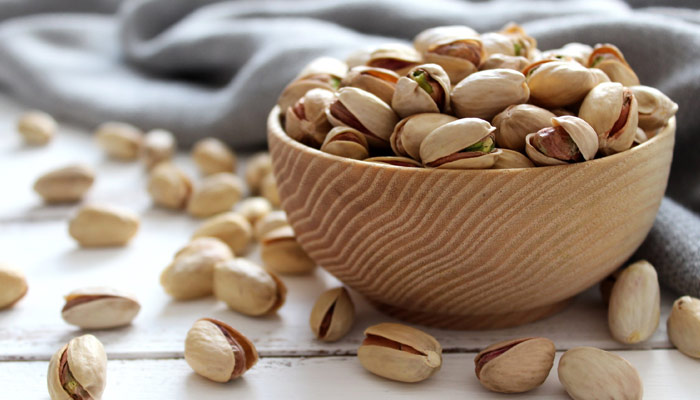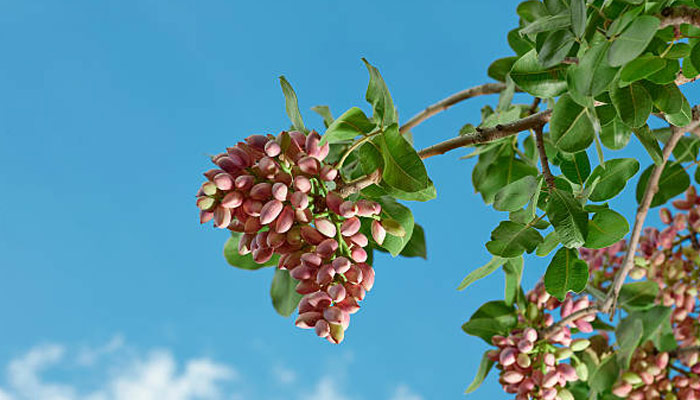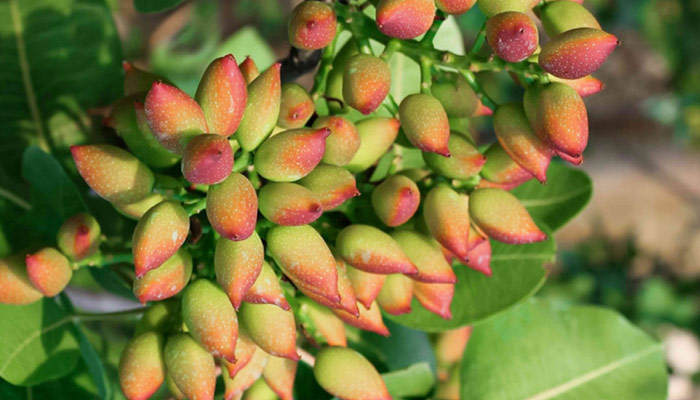History of Pistachio
Archeologists have found evidence from excavations at Jarmo in northeastern Iraq . that pistachio seeds were a common food as early as 6750 BC.The Hanging Gardens of Babylon were said to have contained pistachio trees during the reign of King Merodach-Baladan about 700 BC.The modern pistachio P. vera was first cultivated in Western Asia, where it has long been an important crop in cooler parts of Iran and Iraq. It appears in Dioscurides as pistakia πιστάκια, recognizable as P. vera by its comparison to pine nuts. Its cultivation spread into the Mediterranean world by way of Persia from Syria.
Additionally, remains of the Atlantic pistachio and pistachio seed along with nut-cracking tools were discovered by archaeologists at the Gesher Benot Ya'aqov site in Israel's Hula Valley, dated to 780,000 years ago.
More recently, the pistachio has been cultivated commercially in the English-speaking world, in Australia, and in New Mexico and California, of the United States, where it was introduced in 1854 as a garden tree.David Fairchild of the United States Department of Agriculture introduced hardier cultivars collected in China to California in 1904 and 1905, but it was not promoted as a commercial crop until 1929.Walter T. Swingle’s pistachios from Syria had already fruited well at Niles by 1917.
The earliest records of pistachio in English are around roughly year 1400, with the spellings “pistace” and “pistacia”. The word pistachio comes from medieval Italian pistacchio, which is from classical Latin pistacium, which is from ancient Greek pistákion and pistákē, which is generally believed to be from Middle Persian, although unattested in Middle Persian. Later in Persian, the word is attested in Persian as pista. As mentioned, the tree came to the ancient Greeks from Western Asia.
The pistachio has a long and interesting history. Native to the Middle East, pistachios are one of the oldest flowering nut trees. Recent archeological evidence in Turkey suggests that humans were enjoying them as early as 7,000 B.C. Flourishing in hot climates, pistachios spread from the Middle East to the Mediterranean, quickly becoming a treasured delicacy among royalty, travelers and common folk alike.
Legend has it that the Queen of Sheba decreed pistachios an exclusively royal food, going so far as to forbid commoners from growing the nut for personal use. Nebuchadnezzar, the ancient king of Babylon, had pistachio trees planted in his fabled hanging gardens. And in the first century A.D., the Emperor Vitellius debuted this prized nut in his capital city of Rome. According to Moslem legend, the pistachio nut was one of the foods brought to Earth by Adam.
The pistachio has been used as a dyeing agent and a folk remedy for ailments ranging from toothaches to sclerosis of the liver. The pistachio's high nutritional value and long storage life also made it an indispensable travel item among early explorers and traders. Along with almonds, pistachios were frequently carried by travelers across the ancient Silk Road that connected China with the West.
Additionally, remains of the Atlantic pistachio and pistachio seed along with nut-cracking tools were discovered by archaeologists at the Gesher Benot Ya'aqov site in Israel's Hula Valley, dated to 780,000 years ago.
More recently, the pistachio has been cultivated commercially in the English-speaking world, in Australia, and in New Mexico and California, of the United States, where it was introduced in 1854 as a garden tree.David Fairchild of the United States Department of Agriculture introduced hardier cultivars collected in China to California in 1904 and 1905, but it was not promoted as a commercial crop until 1929.Walter T. Swingle’s pistachios from Syria had already fruited well at Niles by 1917.
The earliest records of pistachio in English are around roughly year 1400, with the spellings “pistace” and “pistacia”. The word pistachio comes from medieval Italian pistacchio, which is from classical Latin pistacium, which is from ancient Greek pistákion and pistákē, which is generally believed to be from Middle Persian, although unattested in Middle Persian. Later in Persian, the word is attested in Persian as pista. As mentioned, the tree came to the ancient Greeks from Western Asia.
The pistachio has a long and interesting history. Native to the Middle East, pistachios are one of the oldest flowering nut trees. Recent archeological evidence in Turkey suggests that humans were enjoying them as early as 7,000 B.C. Flourishing in hot climates, pistachios spread from the Middle East to the Mediterranean, quickly becoming a treasured delicacy among royalty, travelers and common folk alike.
Legend has it that the Queen of Sheba decreed pistachios an exclusively royal food, going so far as to forbid commoners from growing the nut for personal use. Nebuchadnezzar, the ancient king of Babylon, had pistachio trees planted in his fabled hanging gardens. And in the first century A.D., the Emperor Vitellius debuted this prized nut in his capital city of Rome. According to Moslem legend, the pistachio nut was one of the foods brought to Earth by Adam.
The pistachio has been used as a dyeing agent and a folk remedy for ailments ranging from toothaches to sclerosis of the liver. The pistachio's high nutritional value and long storage life also made it an indispensable travel item among early explorers and traders. Along with almonds, pistachios were frequently carried by travelers across the ancient Silk Road that connected China with the West.





